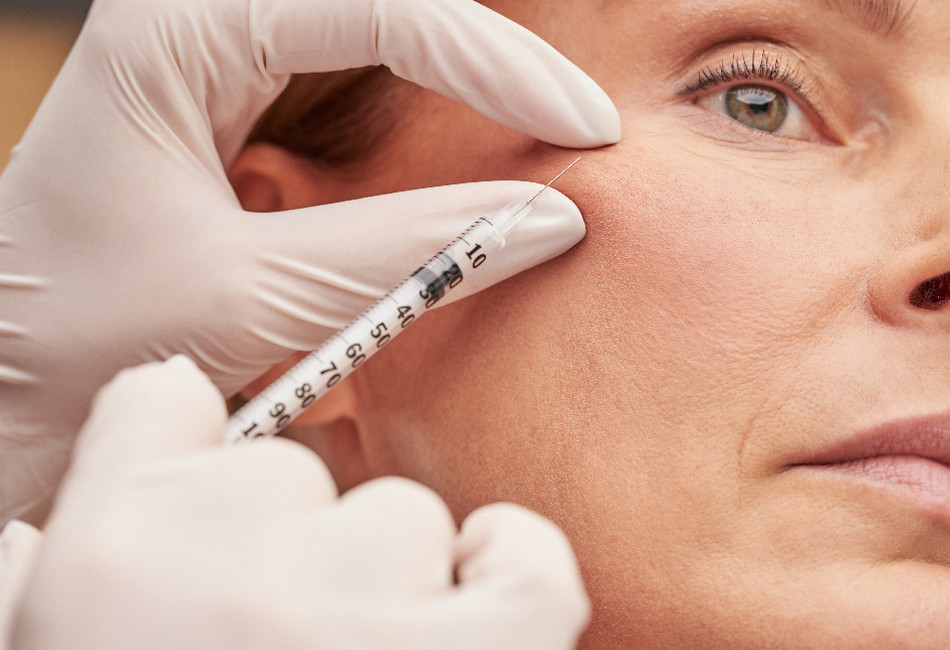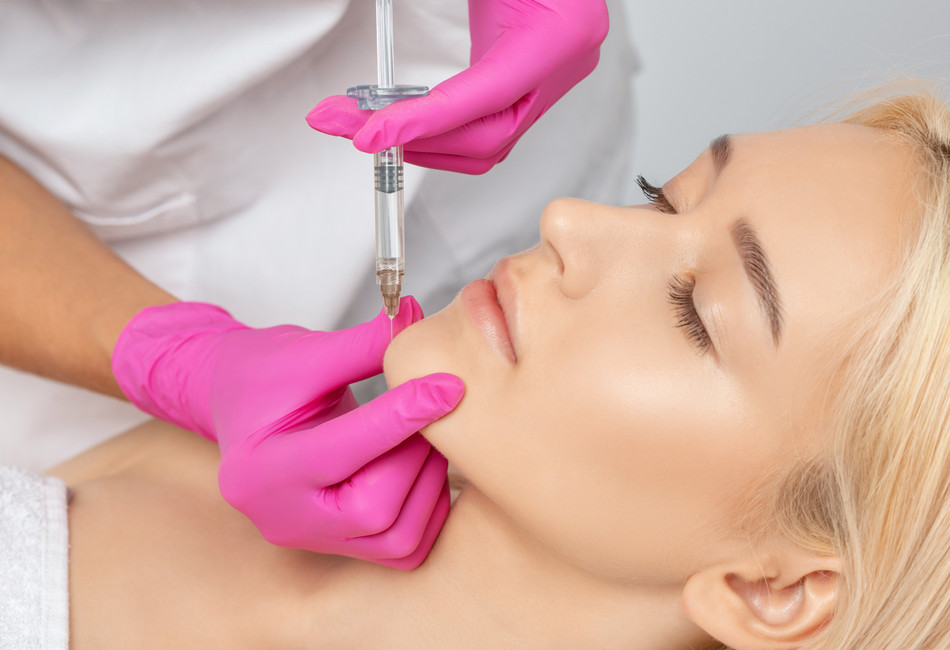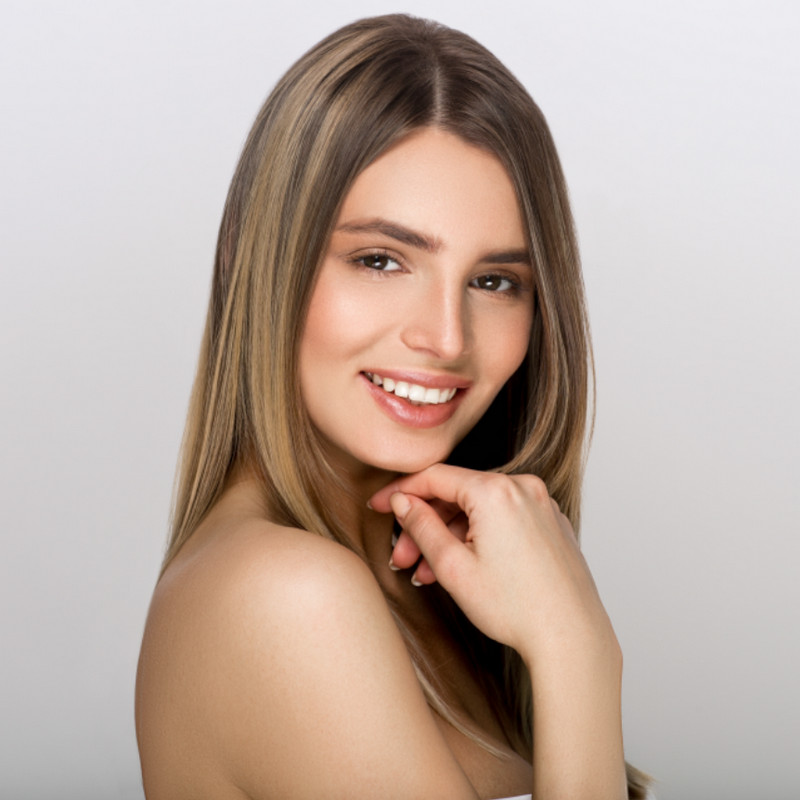Wrinkle injection
Information on fillers and biostimulants
They shape a face, they can be appealing, but they can also be very annoying: WRINTS.
Fine lines, laugh lines, crow's feet and even deeper wrinkles are caused by the natural ageing process of the skin, but are aggravated by sun exposure, smoking and lifestyle. We also experience a progressive loss of volume and elasticity in the skin and lips with increasing age. Even the bone recedes.
The collagen cross-linking in the skin suffers breaks and the elastic network loses its elasticity. These changes can be significantly reduced and partially reversed in a small outpatient treatment.
By using anti-wrinkle injections or volume fillers and bio-stimulants, we can fill the tissue in the troublesome areas with hyaluronic acid, poly-lactic acid or calcium hydroxyl apatite - and also combinations of these substances. Thin threads inserted under the wrinkles also have a nice stabilizing effect. Botox reduces mimic wrinkles and prevents deeper wrinkles from forming.
Wrinkles are smoothed, lips are beautified, lost volume is restored and the skin's elasticity and ability to retain water is restored.
Fillers, lip augmentation and bio-stimulants - the most important facts in brief
- Technical term: filler, lip augmentation, bio-stimulants, volumization
- Anesthesia: often not required, possibly local anesthesia
- Treatment time: 15 - 30 minutes
- Aftercare: local cooling in the practice
- Socially acceptable: after a few hours
- Ready for work: the following day
- Closed season: no sport or sauna in the next 48 hours
- Costs: CHF 400-1600, depending on the dose required
Further details on wrinkle injections
Sunken areas of skin, especially the zygomatic region or the temples, for example, can be refilled with volume. This gives the face a more youthful expression and tightens fine lines. However, defining the angle of the chin or changing the chin area itself also helps to even out the expression.
Individual, more pronounced mimic wrinkles can be treated well with filling materials (so-called "fillers"), which are injected with very thin needles under the depression (wrinkle) to be lifted and, thanks to this volume effect, eliminate the wrinkle or make it mostly disappear
We only use substances that have been tested and approved by the Federal Health Office, such as Hyaluronic acids from "Juvederm", "Teosyal", "Croma", "Merz" and othersfurthermore Hydroxyl apatite as original preparations such as "Radiesse", "HArmoniCA" as well as poly-lactic acid preparations such as "Ellansee" and "Sculptra" - no dubious gray imports of questionable provenance.
Depending on the treatment objective, products of different molecular sizes and degrees of cross-linking are used (the durability in the tissue also depends on this).
The effect of these various treatments is immediately visible, but builds up over time. Depending on the product, the wrinkles continue to appear over a few days (or several weeks with the stimulants). In the case of very deeply ingrained wrinkles, a so-called "subcision" can also be performed. This is the cutting of an adhesion of the fold that extends into the depth of the skin using a sharp needle and then filling this sunken area of skin with the patient's own fatty tissue. own fatty tissue be refilled with the patient's own fatty tissue.
In principle, only biodegradable substances are used, which are completely reabsorbed in the body after a limited shelf life. If mimic wrinkles are filled with biodegradable fillers, the effect usually lasts for 6 to 24 months, depending on the substance and lifestyle habits.
Poly-lactic acid products such as "Ellansé" and "Sculptra"; hydroxyl apatite such as "Radiesse" - or combination products such as "HArmonyCa" have a filling effect on the one hand, while on the other they strongly stimulate the fibroblasts and thus the formation of new collagen. In this way, the body itself builds up elastic volume in the desired regions.
For collagen restructuring and stimulation : here come "Sculptra" and "Sunekos" are used.
These have no volume effect of their own but generate new collagen and repair the cross-linking of the collagen fibers and give new elasticity, firmness and water-binding capacity.
The preparation "ProfHilo" is a low-injury hyaluronic acid which, when injected superficially under the skin, is distributed fluidly in the subcutaneous area, where it creates a beautiful plumpness, water-binding capacity and a glow without injecting specific individual structures. This application is normally repeated about every 6 months.
The insertion of thin threads(thinner than in a thread lift) can also lift and stabilize sunken areas of skin. This is particularly useful for deeper wrinkles or "creases" on the upper lip. Here we use "Croma" products. These threads stimulate collagen biosynthesis and fibroblast activity.
Another excellent, slightly more complex method of filling tissue is to use the patient's own fatty tissue. A small amount of these fat cells must be taken from another part of the body (usually the waist/hips) under local anaesthetic and, after appropriate preparation, are injected under the area to be filled using special needles.
As these are the patient's own living cells, there is no foreign body reaction, only swelling and a discreet reddening after the treatment. Depending on the nutrient supply from the surrounding tissue, experience has shown that 40-70% of these injected fat cells grow back and thus achieve a permanent filling effect.
Lip augmentation and contouring are excellent with hyaluronic acid preparations. Sensitive injections can be used to change both the lip contour and, in particular, the lip volume; the shape of the lips can also be modified. There are countless techniques for achieving the desired result. As experienced users with many years of experience, we can realize your wishes and ideas. The treatment is hardly painful (all injectables contain a local anesthetic). Using the latest, smooth hyaluronic fillers, we achieve a natural, impressive result.
Botox is of course also used to treat wrinkles and, especially as a prophylaxis, prevents the deeper burrowing of mimic wrinkles, including upper lip wrinkles (popularly known somewhat uncharitably as "smoker's wrinkles").
In the lip area, Botox can also be used for the "LipFlip", an application in which an injection into the upper lip muscles causes an eversion of the lip, making the red of the lip appear more prominent and thus making the lip appear more voluminous. A simple but effective application.
After applying anesthetic cream and / or injecting local anesthesia, the filling substance is carefully injected into the subcutaneous tissue.
The substances also contain an anesthetic substance so that hardly any pain is felt. The hyaluronic acid or filler preparation is injected with a very fine needle directly under the wrinkles or above the bone (periosteum) to fill the volume. The "filler" takes immediate effect here by "filling up" the sagging skin with volume from below. Wrinkles are thus reduced or completely smoothed, and sagging tissue regions are lifted and evened out. The tissue is also supplied with new moisture, as hyaluronic acid stores water in its molecular structure, making the complexion appear fresher and healthier.
This effect is particularly striking for lip augmentation and a beautiful result can be seen immediately. The threads are inserted under the skin using very thin needles. The volume effect is immediately visible, but takes 3-5 days to fully build up. The biostimulants (such as Sunekos) are injected very superficially into the skin using extremely thin needles. This does not even require anesthesia.
The filler materials are well tolerated and biocompatible (integrate into the tissue and are not recognizable as foreign bodies). They are substances that occur naturally in the human body.
Serious side effects do not occur; however, a certain amount of redness and swelling should be tolerated for the first 1-2 days. Ultimately, sensitivity reactions to carrier substances / accompanying substances can never be completely ruled out.
As with any cosmetic procedure, the cost of treatment with fillers can vary greatly and depends on the amount of active ingredient used. Naturally, the costs incurred will be discussed and determined in advance.
Depending on the scope and materials required, CHF 400-1600 should be budgeted.
Health insurance companies do not cover the application as it is an aesthetic treatment of choice.
The cost of an initial on-site consultation is CHF 150. This amount can be credited towards your treatment if it takes place within 6 months.
If you do not show up for the bindingly agreed initial appointment, a cancellation fee of CHF 150 will be charged. If you do not show up for the bindingly agreed treatment appointment, a cancellation fee of CHF 250 will be charged.




